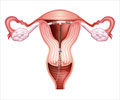While researchers have known for many years that past oral contraceptive use significantly lowers the risk of ovarian and uterine cancers later in life, a new study in monkeys may
A new study in monkeys may shed light on the mechanism behind why past oral contraceptive use significantly lowers the risk of ovarian and uterine cancers later in life.
While studying the effect of post-menopausal dietary soy consumption on estrogen metabolism in cynomolgus monkeys, researchers at Wake Forest University School of Medicine discovered that monkeys who had been given birth control earlier in life had a reduced amount of estrogen excreted in their urine.The discovery was particularly remarkable because it was found three years after oral contraceptive treatment was stopped, roughly the equivalent of a decade of life in a human.
This new observation in monkeys may have put researchers one step closer to understanding why past oral contraceptive use dramatically lowers the risk of ovarian and uterine cancers later in life.
Past oral contraceptive use appears to result in a long-term change in the way the monkeys' bodies process hormones.
While researchers don't yet understand the precise mechanism by which hormone levels are being affected, they do know that both the level of estrogen in the blood and the amount of estrogen being excreted in urine are lowered with past oral contraceptive use, which may mean that the oral contraceptive use is somehow leading to a diminished synthesis of estrogen.
"Hormone exposure has long been known to be important in cancer risk. These effects are robust, and we believe this discovery could be translated fairly quickly into a study in women. If our results are confirmed to also occur in women, they could change the way we look at oral contraceptives and cancer risk," said J. Mark Cline, D.V.M., Ph.D., and senior researcher on the project.
The study appears in this month's issue of Cancer Epidemiology, Biomarkers and Prevention.
RAS/SK
 MEDINDIA
MEDINDIA




 Email
Email










